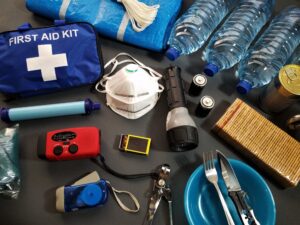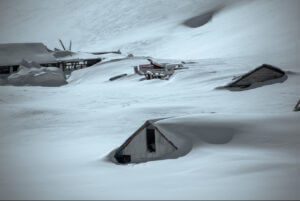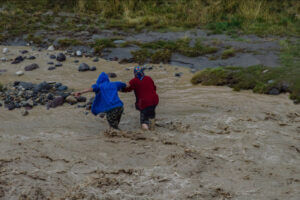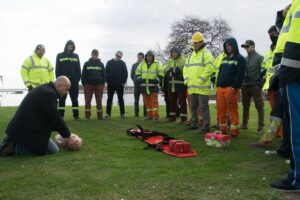72-Hour Survival Prepping: Your Path to Peace of Mind in Any Crisis
In most people’s lives, a true survival event will last no more than 72 hours. A perfect example of this is the emergency experienced in Tonga in January 2022 when the Hunga Tonga underwater volcano erupted, thrusting people into a battle for their lives against tsunamis for two harrowing days. Although some events have unfolded that lasted longer, the very least you want to prepare for is a three-day survival event when you will be without power or access to certain comfort items.
Preparing for the Unpredictable
Preparing for a 72-hour emergency is akin to having a safety net of earnings that covers three months’ worth of your finances. It’s a short period of time to sustain you through an uncomfortable situation. Imagine it as a brief pause in your daily life, one that could potentially save you and your loved ones from undue suffering.

The reason you have a 72-hour threshold of preparation as a minimum is because that’s approximately how long it will take government officials or emergency agencies to show up and offer assistance to everyone in need. Those initial three days are often the most chaotic, where panic reigns, and individuals scramble to find their footing in the midst of a disaster. Having preparations that will get you through this critical window means you have all of your most important and immediate needs met, including food, water, and shelter.
Just knowing you have your supplies ready in case of a natural disaster or other type of emergency can deliver the peace of mind you need to weather any storm. If you live in an area that is prone to things like hurricanes, floods, wildfires, or even power outages, a 72-hour prepper supply is not just a convenience, but a necessity for you.
Assessing Your 72-Hour Survival Risk
Before diving into preparation, it’s essential to assess the potential risks specific to your geographic location. You always want to prepare for a wide range of situations when you are thinking about overall survival preparations, but for your 72-hour risk assessment, you’ll want to focus on the most likely scenarios that could happen where you live.
For instance, if you reside in North Texas or Oklahoma in Tornado Alley, your primary focus should be on preparing for tornado situations. Similarly, if you live on the East Coast or South Texas, gearing up for hurricanes and floods should top your list.

Your geographic location plays a pivotal role in how you prepare for these critical three days. If you live near a fault line, you’ll have to prepare for an earthquake. You might even need different preparations depending on what time of year it is since certain disasters are seasonal.
However, some events don’t adhere to any timeline. Living near train tracks or an industrial plant may put you at risk of a chemical spill or hazardous situation that requires you to survive. Additionally, if you reside in a region prone to civil unrest and chaos, preparing for short-term situations like these becomes crucial.
Supplies to Ensure Survival
While there are many basic needs you’ll want to have on hand during a 72-hour emergency, such as food, water, and shelter, you may need specific supplies based on your risk assessment.
For example, if you’re in a flood zone, materials to keep water from entering your home should be a priority. Likewise, having the right masks for situations like earthquakes or wildfires where smoke and dust can make breathing difficult is essential.
Water should be one of your first concerns. Many short-term survival situations can jeopardize your water supply, rendering tap water undrinkable. Ensure you have water purification supplies and a ready-made store of water that you can use immediately.
Non-perishable, easy-to-eat food is crucial in the event you can’t cook due to a lack of power or adverse weather conditions. Having a generator that can sustain your family and food sources for that duration can provide added comfort.
Even if you’re at home, depending on the situation, you may need additional shelter supplies. During the winter storm that struck Texas, those with tents set up in their homes were able to retain warmth due to the enclosed space, while others without shelter saw temperatures plummet.
Having basic first aid supplies ready is equally important. You may need to administer first aid for scrapes or even broken bones, so ensure you have the necessary medical supplies on hand.
Additionally, it’s crucial to have a way to communicate with emergency services, allowing you to convey your location and the condition of those in your care accurately. Don’t forget to have cash on hand in small denominations, as debit or credit cards may not be usable during short-term emergencies.
Training for Survival
In addition to supplies, specialized training is essential for different situations. For example, understanding how to prepare your home for a threatening wildfire or flood can be invaluable.
In a civil unrest situation, you might need training on securing and protecting your home and loved ones. Enrolling in classes that teach survival skills or self-defense can be a proactive step toward readiness.
Assigning responsibilities within your family is vital when an emergency arises. Everyone should know their role and what to do, and practice these roles periodically. This preparation ensures that when an event occurs, each family member operates on autopilot rather than panicking.
In some cases, your family may have to evacuate. Practicing evacuation plans, especially if family members are separated between work, school, and home locations, ensures you can reunite and move forward from a central meeting point.
The goal of preparing for at least 72 hours is to eliminate the anxiety that plagues others during crises. By investing time and minimal resources in gathering supplies and training for potential disasters, you and your family gain peace of mind and the ability to weather any storm.
As time passes and your supply stores grow, you’ll not only have enough for three days but for three weeks, three months, and even three years. Keeping your preparations discreet is wise, preventing the risk of being raided by those without a plan in place during times of crisis.
Sustainability and Community in Survival Prepping
Beyond individual readiness, it’s worth highlighting the importance of sustainability and community in survival prepping. While preparing for the first 72 hours is crucial, having a long-term perspective can further fortify your resilience. Consider incorporating sustainable practices into your preparations, such as rainwater harvesting, solar power, and home gardening. These initiatives not only bolster your self-sufficiency but also reduce the strain on external resources during crises.
Moreover, fostering a sense of community is paramount in times of disaster. Building connections with your neighbors and local community can lead to resource-sharing, mutual support, and enhanced security. Community resilience can often mean the difference between merely surviving and thriving during extended emergencies. So, consider organizing neighborhood emergency response teams, participating in community drills, and sharing your knowledge and resources with others while still keeping quiet about the resources and survival drink and food stocks and supplies you may have stored at home.
Conclusion
In a world filled with uncertainty, it’s crucial to be ready for unexpected challenges. Preparing for a 72-hour emergency ensures you and your loved ones have the essentials to survive the critical initial period of chaos and uncertainty. By assessing your specific risks, gathering necessary supplies, and obtaining training, you not only protect yourself but also find peace of mind in knowing you’re prepared for whatever may come your way.
Remember, it’s better to be over-prepared than underprepared when it comes to your safety and survival.
Check out the next article in our Survival Prepping 101 Course here: Part 6 of Survival Prepping 101
If you missed Part 4 of our Survival Prepping 101 series you can check it out here: Part 4 of Survival Prepping 101


